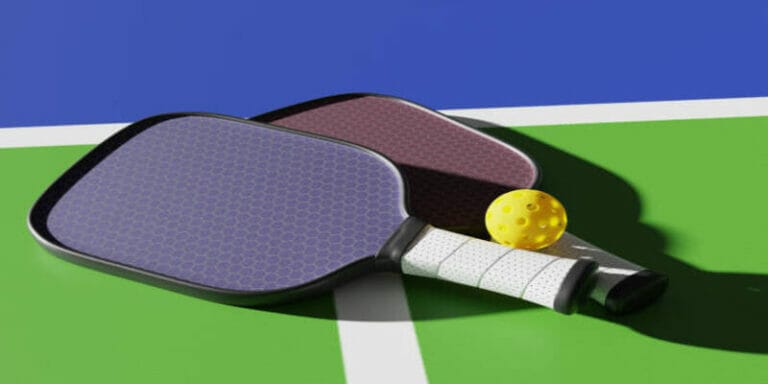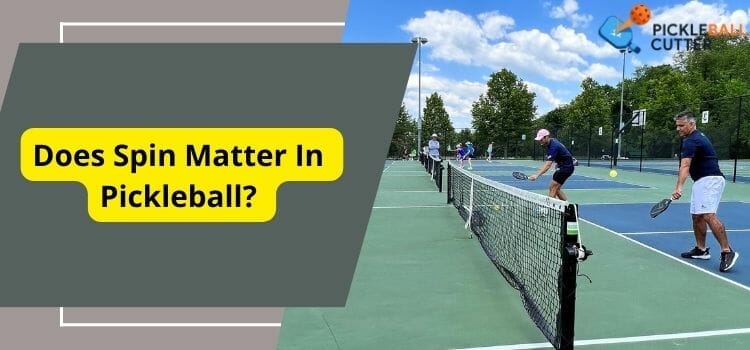What Is A Dink In Pickleball? Exploring Techniques And Strategies

Are you ready to take your pickleball game to the next level? If so, it’s time to delve into the world of dinks! But wait, what exactly is a dink in pickleball?
A dink in pickleball is a skillful shot where the player softly taps the ball over the net, requiring finesse and accuracy rather than power, making it a strategic gem in the game.
Here we’ll explore the ins and outs of this essential technique that can give you an edge on the court. From different types of dinks to strategies for perfect placement, we’ll equip you with all the knowledge you need to become a dinking pro. let’s dive into the wonderful world of dinking in pickleball!
So What Is A Dink In Pickleball?
If you’re new to the sport of pickleball, you may have come across the term “dink” and wondered what it means. Well, let me break it down for you.
Dinking in pickleball is a delicate and controlled shot that involves softly tapping the ball over the net and into your opponent’s court. Unlike power shots that emphasize speed and strength, the dink is all about finesse and precise placement. This technique is often employed when players find themselves near the non-volley zone or the kitchen.
Types Of Dinks In Pickleball

Dinking is a crucial aspect of pickleball strategy, and there are various types of dinks that players can utilize to gain an advantage on the court. Each type requires different techniques and offers unique benefits.
Using these different types of dinks strategically can be highly beneficial during gameplay. They allow you to control the pace, create openings, and put pressure on your opponents by forcing them into uncomfortable positions on the court.
The Cross-Court Dink:
The Cross-Court Dink is a highly effective technique in the game of pickleball. It involves hitting a soft shot diagonally across the court, aiming for your opponent’s sideline. This shot requires finesse and control rather than power.
The goal of the cross-court dink is to place it in such a way that it forces your opponent to run laterally and stretch for the ball, putting them at a disadvantage. By keeping the ball low over the net, you reduce their options for an aggressive response.
It’s important to vary your speed and placement when using this shot. Sometimes hit it slow and deep near the baseline, while other times opt for a shorter, quicker shot closer to the kitchen line.
The Down-The-Line Dink:
In contrast, the down-the-line dink involves directing the ball parallel to the sideline, catching your opponents off-guard, and testing their lateral movement. Precise placement is key to executing this shot effectively.
By using a Down-The-Line Dink at strategic moments during a game, you can disrupt your opponent’s rhythm and potentially gain control of the point.
It can be particularly effective when used after setting up with cross-court shots or during defensive exchanges near the kitchen line.
To master Down-The-Line Dinks, prioritize footwork, balance, and positioning for varied angles. Control speed and spin for unpredictability.
Backspin And Topspin Dinks:
Adding spin to your dinks can add an extra layer of complexity to your shots. Backspin dinks create a slower bounce, making it challenging for opponents to predict the ball’s trajectory. On the other hand, topspin dinks can create sharper angles, potentially pushing opponents out of their comfort zones.
Both types of spin in your pickleball paddle can be effective in different situations during a dinking game. Backspin dinks work well when you’re aiming for placement near or just over the net while keeping low balls out of reach for opponents at baseline positions. Topsin dinks can be particularly useful when you need more height or distance in your shot.
Mastery of spin demands precise practice and timing. Delicate touch, paddle control, and hitting technique influence backspin or topspin—under or through the ball’s segments.
Dinking Strategies And Placement

When it comes to pickleball, dinking is not just about hitting the ball softly over the net. It requires strategy and precise placement to outsmart your opponents. By mastering different dinking strategies, you can gain an upper hand on the court.
- Prioritize Placement for Control: Shift the focus from power to precision in your shots. Use dinks to disrupt opponents’ positions and rhythm. Aim for areas that force opponents into uncomfortable stretches.
- Target the Transition Zone: The transition zone, situated between the kitchen line and the baseline, is a prime target. Shots placed here create challenging opportunities for opponents.
- Cross-Court Craftiness: Employ cross-court shots to exploit lateral movement. Force opponents to cover more ground and create openings. Cross-court shots set up favorable angles for subsequent shots.
- Build Pressure Through Consistency: Consistent shot placement builds pressure over time. Gradually force opponents into unfavorable positions. Create opportunities for more aggressive shots by maintaining consistency.
Mastering dinking strategies takes practice and experience, but once you have a solid understanding of how placement impacts gameplay dynamics, you’ll find yourself gaining an edge over opponents who underestimate this subtle yet powerful technique.
Advantages Of Dink Shots
Dinking is a delicate and strategic shot in pickleball that can give you a significant advantage on the court. By utilizing pickleball dink shots effectively, you can control the tempo of the game and force your opponents into making mistakes.
- Dinking offers a significant advantage by disrupting your opponent’s rhythm. A well-executed hit a dink requires quick adjustments from your opponent, throwing them off balance and limiting their shot power.
- Dinks excel in ball placement. Lowering the ball over the net allows precise targeting, creating pressure on opponents and generating opportunities to exploit openings.
- Energy conservation is another benefit. Dinking preserves energy during long rallies, maintaining ball engagement without exhaustive effort.
- Employing dinks provides repositioning time. After aggressive shots or challenging returns, controlled dinks slow the pace, granting you the chance to regain composure and return to an optimal position for your next move.
The advantages of incorporating effective dinks into your pickleball strategy cannot be underestimated. From disrupting your opponent’s rhythm to improving placement and conserving energy, mastering this skill will undoubtedly enhance your overall performance.
What Is The Best Time To Use The Dink Shot?

The good dink shot is a versatile technique in pickleball that can be used strategically to gain an advantage over your opponents. But when is the best time to use this shot?
Let’s explore some scenarios where the dink shot can be highly effective.
1. One situation where the dink shot shines is when you’re at the kitchen line, also known as the non-volley zone. This close proximity to the net allows for precise placement and control over your shots. By using soft and controlled shots, you can force your opponents into making mistakes or hitting weak returns.
2. The opportune moment for utilizing the dink shot is during a rally with fast-paced exchanges. When both teams are engaged in quick volleys, introducing a well-placed dink can catch your opponents off guard and disrupt their rhythm.
3. if you notice that one of your opponents has a weaker backhand or struggles with low shots, incorporating more dinks into your strategy can exploit these weaknesses. By forcing them to hit difficult shots or awkward angles, you increase the chances of winning points.
4. Timing is crucial when it comes to executing successful dinks. You need patience and good court awareness to identify opportunities where a softer touch would work better than a power shot. Practice regularly to develop precision and consistency with this skill.
The best time to incorporate dinks into your pickleball game varies depending on different factors such as pickleball court positioning, opponent weaknesses, and pace of play. Experiment with different situations during practice sessions and observe how it affects gameplay.
Tips for Hitting Dinks Like a Pro?
Mastering the art of dinking in pickleball takes practice and precision. If you want to improve your dink shots and play like a pro, here are some valuable tips to keep in mind.
- Grip for Precision: Prioritize your grip for paddle control and accuracy. Opt for a relaxed yet firm grip that suits your comfort level, ensuring better command over your next shot.
- Stance for Stability: Focus on body positioning. Adopt a shoulder-width stance with slightly bent knees, distributing weight evenly. This foundation balances stability with agility for swift responses.
- Gentle Hands, Targeted Touch: Embrace soft hands over brute force. Use finesse to guide the ball’s trajectory, preventing excessive height or distance. Subtle control leads to precision.
- Master the Abbreviated Swing: Opt for a concise swing, foregoing full motion. Keep the pickleball paddle face open and aim for the ball’s center, attaining ideal placement without unnecessary power.
- Timing and Anticipation: Sharpen timing by observing your opponent’s movements. Predict their return shot, readying yourself to swiftly execute a well-timed dink in response.”
By following these tips consistently over time, you’ll enhance your ability to hit dinks like a pro! So grab your racket and start practicing – soon enough those precise placement shots will become one of your greatest strengths on the court!
Common Mistakes When Doing A Dink And How To Avoid Them
Mastering the dink shot in pickleball takes time, practice, and finesse. While it may seem like a straightforward technique, there are common mistakes that players often make when attempting a dink.
By understanding these pitfalls and learning how to avoid them, you can elevate your soft game and become a more effective player at the net.
- One of the most frequent mistakes is hitting the ball too hard during a dink. The key to successful dinking is maintaining control and finesse rather than power. Aim for soft shots that barely clear the net, giving your opponent less time to react.
- Many players make is failing to adjust their body position for each defensive shot. Proper footwork and positioning are crucial when hit a dink. Make sure you’re balanced with your weight forward, allowing for quick changes in direction as needed.
- A lack of patience can also be detrimental when attempting a dink shot. Rushing or forcing an opportunity can lead to errors. Instead, wait for the right moment – when your opponent has hit a weaker shot or left an opening – before going for the dink.
- Poor paddle control can hinder your ability to execute precise dinks consistently. Grip too tightly on your racket or mishandling it during contact will result in inconsistent shots that lack accuracy and control.
Failing to anticipate your opponent’s reactions is another common mistake made by players new to using the dink effectively. Watch their movements closely and try not to telegraph where you intend to place your shot; this will keep them guessing and off-balance.
Conclusion
Mastering the dink shot in pickleball can greatly enhance your game and give you a strategic advantage on the court. Whether you’re a beginner or an experienced player, understanding and incorporating different types of dinks into your gameplay can help you control the pace, placement, and direction of the ball.
By practicing cross-court and down-the-line dinks, as well as experimenting with backspin and topspin shots, you’ll be able to keep your opponents guessing and force them into making errors. The versatility of the dink shot allows for both offensive and defensive play, giving you options depending on the situation.
Mastering the art of the dink shot is essential for any serious pickleball player looking to improve their skills. By incorporating various techniques and strategies into your gameplay while avoiding common pitfalls.
FAQS
Can you dink in the kitchen in pickleball?
Absolutely, in pickleball, you can execute a dink shot while positioned in the kitchen, also known as the non-volley zone.
What is the purpose of a dink shot?
the purpose of a dink shot in pickleball is multi-faceted. This skillful shot serves to disrupt your opponent’s rhythm and balance, forcing them to make quick adjustments.
What’s the difference between a dink and a drop shot?
While both shots are delicate and controlled, a dink is executed near the net, while a drop shot is hit from the backcourt.






